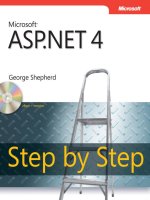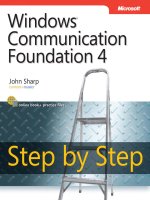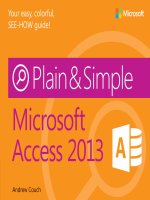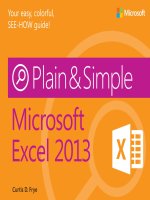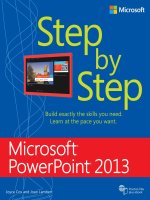microsoft press word 2013 step by step
Bạn đang xem bản rút gọn của tài liệu. Xem và tải ngay bản đầy đủ của tài liệu tại đây (19.31 MB, 576 trang )
The smart way to learn
Microsoft Word 2013
—one step at a time!
Experience learning made easy—and quickly teach yourself
how to create great-looking documents with Microsoft
Word 2013. With Step by Step, you set the pace—building
and practicing the skills you need, just when you need them!
Lambert
Cox
•
Work with Word on your PC or touch-enabled device
•
Master core tools for designing and editing docs
•
Manage page layout, style, and navigation
•
Organize content in tables, lists, and charts
•
Add pictures, diagrams, and other visuals
•
Create custom styles and templates
Your Step by Step digital content includes:
•
All the book’s practice les—ready to download at:
/>• Fully searchable ebook. See the instruction page at
the back of the book.
Microsoft Word 2013
Follow the easy numbered steps
Use screenshots to check your work
Get helpful tips and pointers
Build your skills hands-on with
ready-made practice les
1
2
3
4
1
2
3
4
microsoft.com/mspress
Microsoft Ofce/
Microsoft Word
ISBN: 978-0-7356-6912-3
U.S.A. $29.99
Canada $31.99
[Recommended]
spine = 1.15”
Build exactly the skills you need.
Learn at the pace you want.
Microsoft
Word 2013
®
Joan Lambert and Joyce Cox
Practice les
plus ebook
PUBLISHED BY
Microsoft Press
A Division of Microsoft Corporation
One Microsoft Way
Redmond, Washington 98052-6399
Copyright © 2013 by Joyce Cox and Joan Lambert
All rights reserved. No part of the contents of this book may be reproduced or transmitted in any form or by any
means without the written permission of the publisher.
Library of Congress Control Number: 2012956091
ISBN: 978-0-7356-6912-3
Printed and bound in the United States of America.
First Printing
Microsoft Press books are available through booksellers and distributors worldwide. If you need support related
to this book, email Microsoft Press Book Support at Please tell us what you think of
this book at />Microsoft and the trademarks listed at />Trademarks/EN-US.aspx are trademarks of the Microsoft group of companies. All other marks are property of
their respective owners.
The example companies, organizations, products, domain names, email addresses, logos, people, places, and
events depicted herein are ctitious. No association with any real company, organization, product, domain name,
email address, logo, person, place, or event is intended or should be inferred.
This book expresses the author’s views and opinions. The information contained in this book is provided without
any express, statutory, or implied warranties. Neither the authors, Microsoft Corporation, nor its resellers, or
distributors will be held liable for any damages caused or alleged to be caused either directly or indirectly by
this book.
Acquisitions Editor: Rosemary Caperton
Editorial Production: Online Training Solutions, Inc.
Technical Reviewer: Rob Carr
Copyeditor: Kathy Krause
Indexer: Jan Bednarczuk
Cover: Microsoft Press Brand Team
Contents iii
Contents
Introduction xi
Who this book is for xi
How this book is organized xi
Download the practice les xii
Your companion ebook xiv
Get support and give feedback xv
Errata xv
We want to hear from you xv
Stay in touch xv
PART 1
Basic Word documents
1 Explore Microsoft Word 2013 3
Identifying new features of Word 2013 6
If you are upgrading from Word 2010 6
If you are upgrading from Word 2007 7
If you are upgrading from Word 2003 8
Working in the Word 2013 user interface 9
Identifying program window elements 10
Sidebar: About buttons and arrows 13
Working with the ribbon 14
Sidebar: Adapting exercise steps 18
Opening, navigating, and closing documents 31
Viewing documents in different ways 37
Getting help with Word 2013 46
Key points 49
iv Contents
2 Enter, edit, and proofread text 51
Starting, entering text in, and saving documents 52
Sidebar: Saving les to SkyDrive 54
Sidebar: Document compatibility with earlier versions of Word 58
Modifying text 58
Sidebar: Inserting one document into another 59
Sidebar: About the Clipboard 67
Finding and replacing text 68
Fine-tuning text 75
Sidebar: Installing Ofce tools 84
Sidebar: Viewing document statistics 84
Sidebar: Modifying spelling and grammar checking settings 85
Correcting spelling and grammatical errors 86
Key points 91
3 Modify the structure and appearance of text 93
Applying styles to text 94
Changing a document’s theme 102
Manually changing the look of characters 108
Sidebar: Character formatting and case considerations 118
Manually changing the look of paragraphs 118
Sidebar: Finding and replacing formatting 130
Creating and modifying lists 130
Sidebar: Formatting text as you type 136
Key points 137
Contents v
4 Organize information in columns and tables 139
Presenting information in columns 140
Creating tabbed lists 147
Presenting information in tables 149
Sidebar: Performing calculations in tables 155
Sidebar: Other table layout options 160
Formatting tables 161
Sidebar: Quick Tables 162
Key points 167
5 Add simple graphic elements 169
Inserting and modifying pictures 170
Sidebar: About online pictures and video clips 177
Inserting screen clippings 178
Drawing and modifying shapes 180
Adding WordArt text 185
Sidebar: Formatting the rst letter of a paragraph as a drop cap 190
Sidebar: Inserting symbols 191
Key points 191
6 Preview, print, and distribute documents 193
Previewing and adjusting page layout 194
Controlling what appears on each page 200
Preparing documents for electronic distribution 206
Sidebar: Digitally signing documents 211
Printing and sending documents 212
Key points 219
vi Contents
PART 2
Document enhancements
7 Insert and modify diagrams 223
Creating diagrams 224
Modifying diagrams 231
Creating picture diagrams 239
Key points 243
8 Insert and modify charts 245
Inserting charts 246
Modifying charts 250
Using existing data in charts 259
Key points 263
9 Add visual elements 265
Changing a document’s background 266
Adding watermarks 272
Inserting preformatted document parts 276
Sidebar: Drawing text boxes 286
Building equations 288
Sidebar: Setting mathematical AutoCorrect options 294
Key points 295
10 Organize and arrange content 297
Reorganizing document outlines 298
Arranging objects on the page 304
Using tables to control page layout 315
Key points 319
Contents vii
11 Create documents for use outside of Word 321
Saving Word documents in other formats 322
Sidebar: Editing a PDF le in Word 324
Designing accessible documents 329
Creating and modifying web documents 333
Creating and publishing blog posts 342
Key points 343
PART 3
Additional techniques
12 Link to information and content 347
Linking to external resources 348
Embedding linked objects 353
Inserting and linking to bookmarks 360
Displaying document information in elds 365
Key points 371
13 Reference content and content sources 373
Inserting and modifying footnotes and endnotes 374
Creating and modifying tables of contents 378
Sidebar: Tables of authorities 385
Sidebar: Tables of gures 386
Creating and modifying indexes 388
Adding sources and compiling bibliographies 394
Key points
401
viii Contents
14 Work with mail merge 403
Preparing data sources 404
Sidebar: Using an Outlook contacts list as a data source 411
Preparing main documents 411
Merging main documents and data sources 415
Sidebar: Printing envelopes 418
Sending personalized email messages to multiple recipients 419
Creating and printing labels 423
Key points 427
15 Collaborate on documents 429
Adding and reviewing comments 430
Tracking and managing document changes 434
Comparing and merging documents 438
Sidebar: Managing document versions 442
Password-protecting documents 442
Controlling changes 446
Coauthoring documents 450
Sidebar: Restricting who can do what to documents 451
Key points 451
16 Work in Word more efciently 453
Creating custom styles and templates 454
Creating and attaching templates 454
Creating and modifying styles 460
Creating custom building blocks 472
Changing default program options 478
Customizing the Quick Access Toolbar 487
Sidebar: Using add-ins 492
Customizing the ribbon 494
Sidebar: Customizing the status bar 500
Key points 501
Contents ix
Glossary 503
Keyboard shortcuts 511
Word 2013 keyboard shortcuts 511
Perform common tasks 511
Work with documents and webpages 512
Edit and move text and graphics 514
Apply character and paragraph formatting 519
Work with mail merge and elds 521
Use the Language bar 522
Perform function key tasks 522
Ofce 2013 keyboard shortcuts 525
Display and use windows 525
Use dialog boxes 525
Use the Backstage view 527
Navigate the ribbon 527
Change the keyboard focus without using the mouse 527
Undo and redo actions 528
Change or resize the font 528
Move around in text or cells 528
Move around in and work in tables 529
Access and use panes and galleries 529
Access and use available actions 530
Find and replace content 530
Use the Help window 530
Creating custom keyboard shortcuts 531
Index 533
About the authors 557
How to download your ebook 559
Survey page 560
Introduction xi
Introduction
Part of the Microsoft Ofce 2013 suite of programs, Microsoft Word 2013 is a sophisticated
word-processing program that helps you quickly and efciently author, format, and publish
all the business and personal documents you are ever likely to need. Microsoft Word 2013
Step by Step offers a comprehensive look at the features of Word that most people will use
most frequently.
Who this book is for
Microsoft Word 2013 Step by Step and other books in the Step by Step series are designed
for beginning to intermediate-level computer users. Examples shown in the book generally
pertain to small and medium-sized businesses but teach skills that can be used in organiza-
tions of any size. Whether you are already comfortable working in Word and want to learn
about new features in Word 2013 or are new to Word, this book provides invaluable hands-
on experience so that you can create and modify professional documents with ease.
How this book is organized
This book is divided into three parts. Part 1 teaches readers how to create, print, and dis-
tribute standard documents in Word 2013. Tutorials lead the reader through the process
of creating document elements such as formatted text, columns, lists, tables, and simple
graphics. Part 2 discusses ways of enhancing standard document content with diagrams,
charts, and other visual elements; organizing and arranging content; and saving Word les
in various formats. Part 3 delves into advanced techniques and tools that include creating
reference elements, creating mail merge documents, collaborating on document creation,
and customizing program functionality to t the way you work. This three-part structure
allows readers who are new to the program to acquire basic skills and then build on them,
while readers who are comfortable with Word 2013 basics can focus on material that is of
the most interest to them.
Chapter 1 contains introductory information that will primarily be of interest to readers
who are new to Word or are upgrading from Word 2003 or an earlier version. If you have
worked with a more recent version of Word, you might want to skip directly to Chapter 2.
xii Introduction
This book has been designed to lead you step by step through all the tasks you’re most
likely to want to perform with Word 2013. If you start at the beginning and work your way
through all the exercises, you will gain enough prociency to be able to create and work
with most types of Word documents. However, each topic is self-contained, so you can
jump in anywhere to acquire exactly the skills you need.
Download the practice les
Before you can complete the exercises in this book, you need to download the book’s prac-
tice les to your computer. These practice les can be downloaded from the following page:
/>IMPORTANT The Word 2013 program is not available from this website. You should purchase and
install that program before using this book.
If you would like to be able to refer to the completed versions of practice les at a later
time, you can save the practice les that you modify while working through the exercises in
this book. If you save your changes and later want to repeat the exercise, you can download
the original practice les again.
The following table lists the practice les for this book.
Chapter File
Chapter 1: Explore Microsoft Word 2013 Prices.docx
Procedures.docx
Rules.docx
Chapter 2: Enter, edit, and proofread text Brochure.docx
Letter.docx
Orientation.docx
Regulations.docx
Chapter 3: Modify the structure and appearance of text Association.docx
BambooInformation.docx
BambooStyled.docx
Cottage.docx
Guidelines.docx
Introduction xiii
Chapter File
Chapter 4: Organize information in columns and tables ConsultationA.docx
ConsultationB.docx
RepairCosts.docx
RoomPlanner.docx
Chapter 5: Add simple graphic elements AgendaDraft.docx
Announcement.docx
Authors.docx
Joan.jpg
Joyce.jpg
OTSI-Logo.png
Chapter 6: Preview, print, and distribute documents InfoSheetA.docx
InfoSheetB.docx
InfoSheetC.docx
OfceInfo.docx
Chapter 7: Insert and modify diagrams Garden.jpg
Neighborhood.docx
Park.jpg
Pond.jpg
ServiceA.docx
ServiceB.docx
Woods.jpg
Chapter 8: Insert and modify charts CottageA.docx
CottageB.docx
CottageC.docx
Temperature.xlsx
Chapter 9: Add visual elements AuthorsDraft.docx
Flyer.docx
MarbleFloor.jpg
OTSI-Logo.png
Welcome.docx
Chapter 10: Organize and arrange content BambooInfo.docx
DeliveryTruckPurchase.docx
Loan.xlsx
LoanComparisons.docx
OfceProcedures.docx
xiv Introduction
Chapter File
Chapter 11: Create documents for use outside of Word ParkingRules.docx
WebPlanner.docx
Chapter 12: Link to information and content Conductors.docx
Conductors.pptx
ProceduresFields.docx
RulesBookmarks.docx
Symphony.docx
VisitorGuide.docx
Chapter 13: Reference content and content sources BambooBibliography.docx
BambooInfoA.docx
BambooInfoB.docx
ProceduresContents.docx
RulesIndex.docx
Chapter 14: Work with mail merge AnniversaryLetter.docx
CustomerList.xlsx
ThankYouEmail.docx
Chapter 15: Collaborate on documents CompetitiveAnalysisA.docx
CompetitiveAnalysisB.docx
Loans.docx
ProceduresRestricted.docx
Service.docx
ServiceCP.docx
ServiceTA.docx
Chapter 16: Work in Word more efciently Agenda.docx
AuthorsBlank.docx
Bamboo.docx
RoomFlyer.docx
Your companion ebook
With the ebook edition of this book, you can do the following:
▪
Search the full text
▪
▪
Copy and paste
To download your ebook, please see the instruction page at the back of the book.
Introduction xv
Get support and give feedback
The following sections provide information about getting help with this book and
contacting us to provide feedback or report errors.
Errata
We’ve made every effort to ensure the accuracy of this book and its companion con-
tent. Any errors that have been reported since this book was published are listed on
our Microsoft Press site at oreilly.com, which you can nd at:
/>If you nd an error that is not already listed, you can report it to us through the same page.
If you need additional support, email Microsoft Press Book Support at mspinput
@microsoft.com.
Please note that product support for Microsoft software is not offered through the
addresses above.
We want to hear from you
At Microsoft Press, your satisfaction is our top priority, and your feedback our most valuable
asset. Please tell us what you think of this book at:
/>The survey is short, and we read every one of your comments and ideas. Thanks in advance
for your input!
Stay in touch
Let’s keep the conversation going! We’re on Twitter at: />
Basic Word
documents
1 Explore Microsoft Word 2013 3
2 Enter, edit, and proofread text 51
3 Modify the structure and appearance
of text 93
4 Organize information in columns
and tables 139
5 Add simple graphic elements 169
6 Preview, print, and distribute documents 193
Chapter at a glance
Identify
Identify new features of Word 2013,
page 6
Work
Work in the Word 2013 user interface,
page 9
View
View documents in different ways,
page 37
Navigate
Open, navigate, and close documents,
page 31
1
3
Explore Microsoft
Word 2013
IN THIS CHAPTER, YOU WILL LEARN HOW TO
▪
Identify new features of Word 2013.
▪
Work in the Word 2013 user interface.
▪
Open, navigate, and close documents.
▪
View documents in different ways.
▪
Get help with Word 2013.
When you use a computer program to create, edit, and format text documents, you are
performing a task known as word processing. Part of the Microsoft Ofce 2013 suite of pro-
grams, Microsoft Word 2013 is one of the most sophisticated word-processing programs
available. By using Word, it is easy to efciently create a wide range of business and per-
sonal documents, from the simplest letter to the most complex report. Word includes many
desktop publishing features that you can use to enhance the appearance of documents so
that they are visually appealing and easy to read.
You can use Word to:
▪
Create professional-looking documents that incorporate impressive graphics.
▪
Give documents a consistent look by applying styles and themes that control the font,
size, color, and effects of text and the page background.
▪
Store and reuse pre-formatted elements such as cover pages and sidebars.
▪
Create personalized mailings to multiple recipients without repetitive typing.
▪
Make information in long documents accessible by compiling tables of contents,
indexes, and bibliographies.
▪
Coauthor documents with team members.
▪
Safeguard documents by controlling who can make changes and the types of changes
that can be made, as well as by removing personal and condential information.
4 Chapter 1 Explore Microsoft Word 2013
For many people, Word is the rst Ofce program they will use. All the Ofce 2013 pro-
grams share a common working environment, called the user interface, so you can apply
basic techniques that you learn in Word, such as those for creating and working with les,
to other Ofce programs.
In this chapter, you’ll learn about some of the different Word programs that are currently
available so you can identify the one you are using. Then you’ll get an overview of the new
features in recent versions of Word to help you identify changes if you’re upgrading from a
previous version. You’ll explore the program’s user interface, and open, navigate, view, and
close documents in various ways. Finally, you’ll explore how to get help with the program.
PRACTICE FILES To complete the exercises in this chapter, you need the practice les
contained in the Chapter01 practice le folder. For more information, see “Download
the practice les” in this book’s Introduction.
Ofce 2013 encompasses a wide variety of programs, including Microsoft Access 2013,
Excel 2013, InfoPath 2013, Lync 2013, OneNote 2013, Outlook 2013, PowerPoint 2013,
Publisher 2013, and Word 2013. Ofce is available in various editions that include different
combinations of Ofce programs; you can also purchase most of the programs individually.
The programs in the Ofce suite are designed to work together to provide highly efcient
methods of getting things done. You can install one or more Ofce programs on your com-
puter. Some programs have multiple versions designed for different platforms. Although
the core purpose of a program remains the same regardless of the platform on which it
runs, the available functionality and the way you interact with the program might be differ-
ent. We provide a brief description of the different Word 2013 programs here so that you
can identify any differences between what appears on your screen and what’s described in
this book.
▪
Word 2013 standard desktop installation The program we work with and depict in
images throughout this book is a desktop installation of Word 2013, meaning that we
installed the program directly on our computers. The standard desktop installation
has all the available Word functionality. It is available as part of the Ofce 2013 suite
of programs, as a freestanding program, or as part of an Ofce 365 subscription that
allows users to install the desktop programs from the Internet.
TIP Ofce 365 is a cloud-based solution that provides a variety of products and ser-
vices through a subscription licensing program. Depending on the subscription plan
purchased, users will have access either to the full Word 2013 desktop installation
and Word Web App or only to Word Web App.
1
▪
Word 2013 RT Tablet-style computers that run Windows RT (a version of Windows 8
that runs only on devices that use a type of processor called an ARM processor) come
preloaded with Ofce Home & Student 2013 RT, which includes Word, Excel, Power-
Point, and OneNote.
The Ofce 2013 RT programs have the functionality of the full programs and also in-
clude a Touch Mode feature to help you work with the program and enter content by
tapping the screen with your nger or with a tool such as a stylus. When Touch Mode
is turned on, the user interface is slightly modied to simplify on-screen interactions,
and an on-screen keyboard is readily available for text input. (You can simplify your
interactions even further by attaching a keyboard and mouse to your Windows RT
computer and interacting with Ofce in the usual manner.)
▪
Word Web App Word Web App may be available in your web browser when you
are working with a document that is stored on a Microsoft SharePoint site or on a
Microsoft SkyDrive. You can review and edit a document by using the Web App, which
runs directly in your browser instead of on your computer. Web Apps are installed in
the online environment in which you’re working and are not part of the desktop ver-
sion that you install directly on your computer. Word Web App is available as part of
Ofce 365 and SharePoint Online subscriptions, and is free on SkyDrive stor age sites.
SEE ALSO For information about saving documents to SkyDrive and SharePoint sites,
see “Starting, entering text in, and saving documents” in Chapter 2, “Enter, edit, and
proofread text.”
Word Web App displays the contents of a document very much like the desktop ap-
plication does. Although the Web App offers only a subset of the commands avail-
able in the full desktop application, it does provide the tools you need to edit, print,
and share documents. Commands that are not available in Word Web App are those
that control functionality, such as the commands for navigating by section or page;
nding and replacing content; inserting fancy graphic elements; changing document
design elements; controlling page breaks, line numbering, and hyphenation; arrang-
ing graphic elements on the page; working with reference elements; creating mail
merge documents; using the research and language tools; working with comments
and tracked changes; and working with multiple documents or document windows.
Both Word Web App and the desktop installation of the program might be available to you
in the online environment. When viewing a document in the Web App, you can click the
Edit Document menu and then choose the version you want to use by clicking Edit In Word
or Edit In Word Web App. If you’re editing a document in the Web App and nd that you
need more functionality than is available, and you have the full version of Word installed on
your computer, you can click Open In Word to open the document in the full version.
Explore Microsoft Word 2013 5
6 Chapter 1 Explore Microsoft Word 2013
Identifying new features of Word 2013
Word 2013 builds on previous versions to provide a powerful set of tools to meet all your
word-processing needs. If you’re upgrading to Word 2013 from a previous version, you’re
probably most interested in the differences between the old and new versions and how
they will affect you, and want to nd out about them in the quickest possible way. The fol-
lowing sections list new features you will want to be aware of, depending on the version of
Word you are upgrading from. Start with the rst section and work down to your previous
version to get the complete picture.
If you are upgrading from Word 2010
If you have been using Word 2010, you might be wondering how Microsoft could have
improved on what seemed like a pretty comprehensive set of features and tools. The new
features introduced between Word 2010 and Word 2013 include the following:
▪
Start screen When you start Word without opening a specic document, the Start
scree provides quick access to recent documents and and to document templates.
▪
Cloud access When you connect your Ofce or Word installation to a Microsoft ac-
count, you have the option of saving documents to your SkyDrive. After you save a
document in a SkyDrive folder or other shared location, you and your colleagues can
simultaneously work on one version of the document.
▪
Previous location bookmark When you close a document, Word marks the location
where you were working. The next time you open the document (even on a different
computer, if the document is saved in a shared location) a Resume Reading alert ap-
pears, to make it easy to return to that location.
▪
Smart guides When you place or move a graphic element on a page, on-screen
guides appear to help you align the graphic with other page elements such as mar-
gins and paragraphs.
▪
Read Mode This view, which replaces the Full Screen Reading view, provides a sim-
pler interface for reviewing documents.
▪
Reply Comment With this new feature you can place comments next to the text
you’re discussing so it’s easy to track the conversation.
▪
Present Online Share your document with others even if they don’t have Word. As
you display the document on your screen, they can follow along in their browsers.
Identifying new features of Word 2013 7
1
▪
Live Layout Text reows instantly when you drag a photo, video, or shape to its new
position. When you release the mouse button, your object and surrounding text stay
where you want them.
▪
PDF Reow When you open a PDF in Word, its paragraphs, lists, tables, and other
content act just like Word content.
If you are upgrading from Word 2007
In addition to the features listed in the previous section, if you’re upgrading from Word
2007, you’ll want to take note of the following features that were introduced in Word 2010:
▪
Backstage view All the tools you need to work with your les, as opposed to their
content, really are accessible from one location. You display the Backstage view by
clicking the File tab, which replaces the Microsoft Ofce Button.
▪
Customizable ribbon The logical next step in the evolution of the command center
that was introduced with Word 2007: create your own tabs and groups to suit the way
you work.
▪
Navigation pane The replacement for the Document Map not only provides a
means of navigating to any heading but also to any page or to any search term
you enter.
▪
Unsaved le recovery Word preserves temporary versions of your unsaved les so
that you can recover them if you need them.
▪
Paste preview No more trial and error when moving items to new locations. Pre-
view what an item will look like in each of the available formats, and then pick the
one you want.
▪
Coauthoring A team of authors can work simultaneously on a document stored in a
SharePoint site document library or SkyDrive folder.
▪
Language support These days, more business is conducted internationally across
language lines than ever before. Not only can you easily tailor the language of your
working environment, but you can also use translation tools to collaborate with team
members in other countries.
▪
Graphics editing After inserting a picture, you can edit it in multiple ways. In addi-
tion to changing color, brightness, and contrast, you can remove the background and,
most exciting of all, apply artistic effects that make it appear like a watercolor, pencil
drawing, or pastel sketch.
8 Chapter 1 Explore Microsoft Word 2013
▪
Text effects WordArt has had a makeover. Not only can WordArt be used to create
distinctive headlines, but its effects can be used on any text.
▪
Screen shots and screen clippings You no longer need to go outside of Word when
you want to insert a screen image into a document. This capability is built into Word.
▪
Improved SmartArt Graphics tool You can include pictures in addition to text in
your SmartArt diagrams.
If you are upgrading from Word 2003
In addition to the features listed in the previous sections, if you’re upgrading from Word
2003, you’ll want to take note of the new features that were introduced in Word 2007. The
Word 2007 upgrade provided a more efcient working environment and included a long
list of new and improved features, including the following:
▪
The ribbon No more hunting through menus, submenus, and dialog boxes. This
interface organizes all the commands most people use most often, making them
quickly accessible from tabs at the top of the program window.
▪
Live Preview Review the effect of a style, theme, or other formatting option before
you apply it.
▪
Building blocks Think AutoText on steroids! Predened building blocks include sets
of matching cover pages, quote boxes, sidebars, and headers and footers.
▪
Style sets and document themes Quickly change the look of a document by apply-
ing a different style set or theme, previewing its effect before making a selection.
▪
SmartArt Graphics tool Use this awesome diagramming tool to create sophisti-
cated diagrams with three-dimensional shapes, transparency, drop shadows, and
other effects.
▪
Improved charting Enter data in a linked Excel worksheet and watch as the data is
instantly plotted in the chart type of your choosing.
▪
Document cleanup Have Word check for and remove comments, hidden text, and
personal information stored as properties before you declare a document nal.
▪
New le format The Microsoft Ofce Open XML Formats reduce le size and help
avoid loss of data.
Working in the Word 2013 user interface 9
1
Working in the Word 2013 user interface
The goal of the Microsoft Ofce working environment is to make working with Ofce docu-
ments, including Microsoft Word documents, Excel workbooks, PowerPoint presentations,
Outlook email messages, and Access database tables, as intuitive as possible.
As with all Ofce 2013 programs, the most common way to start Word is from the Start
screen (Windows 8) or the Start menu (Windows 7) that is displayed when you click at the
left end of the Windows Taskbar. When you start Word without opening a specic docu-
ment, a program starting screen appears, from which you can create a new document or
open an existing one. Either way, when you’re working with a document, it is displayed in a
program window that contains all the tools you need to add and format content.
The Word 2013 program window, displaying a document and the standard program window elements.
